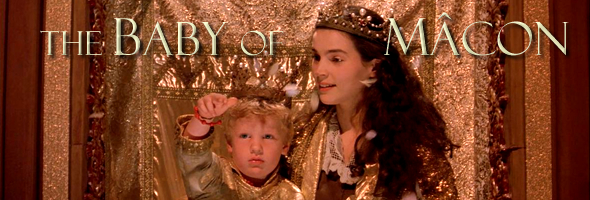
Color, 1993, 117m.
Directed by Peter Greenaway
Starring Julia Ormond, Ralph Fiennes, Philip Stone, Jonathan Lacey, Don Henderson
King Records (Blu-ray & DVD) (Japan R0 HD/NTSC), Atlantic (Blu-Ray & DVD) (Sweden R0/R2 HD/PAL) / WS (2.35:1) (16:9), New Vision (Australia R4 PAL) / WS (1.85:1) / DD2.0
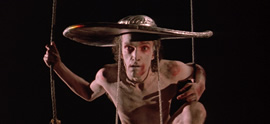 In the early 1990s, things got very strange for art house films.
In the early 1990s, things got very strange for art house films. 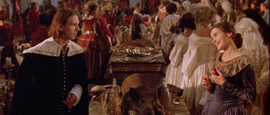 Miramax was becoming a major Hollywood force, Quentin Tarantino was reintroducing chic crime violence, and the Academy Awards once again began taking notice of little films that didn't necessarily come from America. Meanwhile director Peter Greenaway, who had scored a major controversial hit with The Cook, the Thief, His Wife & Her Lover in 1990, confused scores of audiences with his ambitious, wildly experimental, expensive Shakespeare adaptation, Prospero's Books. Rather than soften up, he bared his fangs for his cruelest, most challenging film yet, The Baby of Mâcon, whose graphic but elegantly mounted depictions of mutilation, deformity, infanticide, and gang rape managed to clear out most exhibitor and festival screenings long before the end credits. Not surprisingly, it failed to find an American distributor and was barely shown in Europe; however, the video gray market kept its reputation alive, primarily with help from Greenaway fans and celebrity skin buffs eager to see extended, very brave exposure from future stars Julia Ormond and Ralph Fiennes. If you know what you're getting into, it also happens to be a pretty brilliant film.
Miramax was becoming a major Hollywood force, Quentin Tarantino was reintroducing chic crime violence, and the Academy Awards once again began taking notice of little films that didn't necessarily come from America. Meanwhile director Peter Greenaway, who had scored a major controversial hit with The Cook, the Thief, His Wife & Her Lover in 1990, confused scores of audiences with his ambitious, wildly experimental, expensive Shakespeare adaptation, Prospero's Books. Rather than soften up, he bared his fangs for his cruelest, most challenging film yet, The Baby of Mâcon, whose graphic but elegantly mounted depictions of mutilation, deformity, infanticide, and gang rape managed to clear out most exhibitor and festival screenings long before the end credits. Not surprisingly, it failed to find an American distributor and was barely shown in Europe; however, the video gray market kept its reputation alive, primarily with help from Greenaway fans and celebrity skin buffs eager to see extended, very brave exposure from future stars Julia Ormond and Ralph Fiennes. If you know what you're getting into, it also happens to be a pretty brilliant film.
Designed as a play within a play, this calculated outrage begins with the birth of a beautiful baby to the ugliest woman in the town of Mâcon. The woman’s virginal daughter (Ormond) swiftly passes off the child as her own, a 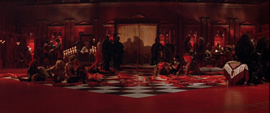 miracle that might save this famine and plague-ridden community. Most of the people fall for the ruse and hail the child as a provider of miracles, but the scientifically inclined bishop’s son (Fiennes) is not so convinced. When he decides to put the
miracle that might save this famine and plague-ridden community. Most of the people fall for the ruse and hail the child as a provider of miracles, but the scientifically inclined bishop’s son (Fiennes) is not so convinced. When he decides to put the 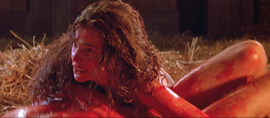 girl’s virginity to the test, horrific and possibly supernatural events are set into motion.
girl’s virginity to the test, horrific and possibly supernatural events are set into motion.
Devoid of the technological Paintbox gimmickry that marks his more recent films, this stylized exercise in theatricality takes place entirely onstage with one of the spectators, a rotund Cosimo de Medici, even taking part in the action. Ultimately the film blurs the line between real life and theater until one cannot tell whether the actors are truly being killed or simply acting; in any case, the notorious mass rape near the end of the film is excruciating to behold (though very little is actually shown), but it drives home to film's point about the disastrous consequences when commerce, organized religion, and moral hypocrisy collide, a perfect companion film to The Devils. The film also marked Greenaway’s first feature without the involvement of composer Michael Nyman, and the loss is sorely felt; here we have only traditional classical tracks, which make little to no impression. Fortunately regular cinematographer Sacha Vierny is still around, displaying a mastery of mobile camerawork and impeccable scope 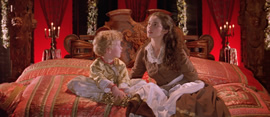 composition that makes this a nonstop feast for the eyes. The theatrical setting based on the extreme, often irrational medieval "miracle plays" could have easily become oppressive or dull, but instead the execution makes it vibrant and wildly unpredictable.
composition that makes this a nonstop feast for the eyes. The theatrical setting based on the extreme, often irrational medieval "miracle plays" could have easily become oppressive or dull, but instead the execution makes it vibrant and wildly unpredictable.
The first DVD from Australia is a compromised presentation of the 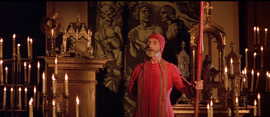 film, which was previously available only on UK VHS and Japanese laserdisc (with rampant optical censorship). The disc plays at a squeezed 1.85:1 aspect ratio on 4:3 players, but when adjusted on a 16:9 television, it plays out at the correct 2.35:1 framing. Black levels are lacking and have a tendency to turn bluish. Detail is on the soft side, but colors are strong for the most part.
film, which was previously available only on UK VHS and Japanese laserdisc (with rampant optical censorship). The disc plays at a squeezed 1.85:1 aspect ratio on 4:3 players, but when adjusted on a 16:9 television, it plays out at the correct 2.35:1 framing. Black levels are lacking and have a tendency to turn bluish. Detail is on the soft side, but colors are strong for the most part.
Far preferable is the much later version from Alliance in Sweden (also carried in Finland and Denmark) features a correctly framed and noticeably superior HD transfer. The region-free Blu-Ray released in 2011 in particular is a real dazzler, with vast amounts of detail visible that standard def couldn't hope to capture; even better, the many scenes bathed in heavy shades of red are now crystal clear and wonderfully filmic. A couple of scenes (especially the opening shots of the plague-riddled narrator) look a bit harsh and grainy, but the vast majority of the transfer is quite impressive. Audio is in English with removeable subtitles in Swedish, Danish, or Finnish. A Blu-ray was also released in Japan as part of a boxed set with Prospero's Books and Drowning by Numbers, also no frills and featuring a 1080p presentation from what appears to be the same source with equally intense colors and detail. Some minor clean up appears to have been done to minimize or remove some specks and dots here and there (just compare the opening scene against the dark background), and the compression is handled a bit more adeptly with a slightly more organic texture during the sweeping tracking shots; don't expect a massive difference though if you're thinking about upgrading. Audio here is DTS-HD 2.0 surround, sounding identical to the Alliance disc.
Updated review on May 20, 2015.







